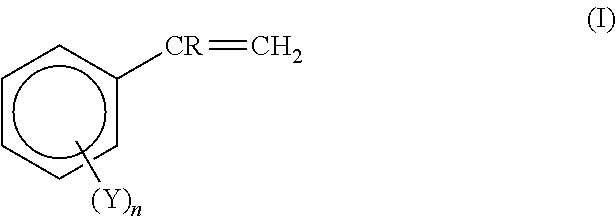Expandable thermoplastic nanocomposite polymeric compositions with an improved thermal insulation capacity
a polymer composition and expansion technology, applied in the field of nanocomposite compositions, can solve the problems of thermal conductivity, different blockage capacity of infrared rays, and inability to fall below this limi
- Summary
- Abstract
- Description
- Claims
- Application Information
AI Technical Summary
Benefits of technology
Problems solved by technology
Method used
Image
Examples
example 1
PART A—Preparation of Nano-Scaled Graphene Plates by the Liquid Exfoliation of Graphite
[0169]20 parts of graphite “UF1 98.5”, produced by Kropfmuhl, are dispersed in 880 parts of N-methyl pyrrolidone (Sigma Aldrich) with a magnetic anchor stirrer. An ultrasonic field is applied, under stirring, by means of a sonotrode calibrated at 20 kHz and with a specific power, calculated on the basis of the absorbed power of the generator, equal to about 100 W / liter. After about 2 hours, the product thus obtained is subjected to centrifugation. The supernatant product is collected and then put again under stirring, this time by means of a mechanical stirrer (Silverson Machines). 100 parts of polystyrene of the EDISTIR N1782 type (polystyrene having a Mw equal to 130,000 g / mol, Mw / Mn=2.3, MFI (200° C., 5 kg) equal to 25 g / 10′, produced by Polimeri Europa) are pulverized and then slowly poured, maintaining the solution under continuous stirring. The temperature is maintained at about 120° C. for ...
example 2
PART A—Preparation of the Concentrate
[0178]The product obtained according to Example 1, parte A, is put under vacuum and the temperature is brought to about 170° C., for 3 hours, under continuous stirring and with a slight bubbling of nitrogen. 500 parts of solvent are thus evaporated and recondensed in a separate container for possible re-use.
PART B—Preparation of Expandable Polystyrene Containing Nano-Scaled Graphene Plates
[0179]89.8 parts of ethylbenzene, 730.0 parts of styrene, 56.2 parts of α-methylstyrene and 0.2 parts of divinylbenzene are fed to a stirred reactor.
[0180]123.8 parts of the preparation obtained in Part A are fed into the reactor and dissolved (total: 1,000 parts). The reaction is then carried out at 125° C. with an average residence time of 2 hours. The fluid composition at the outlet is then fed to a second reactor where the reaction is completed at 135° C. with an average residence time of 2 hours.
[0181]The resulting composition, which is hereafter referred t...
example 3
PART A—Preparation of the Concentrate Of Nano-Scaled Graphene Plates
[0189]Example 1 part A is repeated but using N,N-dimethyl-formamide (DMF) instead of N-methyl pyrrolidone as solvent. 100 parts of the product thus obtained are poured dropwise into a container containing 2,000 parts of methanol. The operation is effected maintaining the container under vigorous stirring. The coagulated composite powder is recovered by filtration, washed with methanol and dried at 120° C. for 12 hours.
PART B—Preparation of Expandable Polystyrene Containing Nano-Scaled Graphene Plates
[0190]A mixture is charged into a closed and stirred container, consisting of 150 parts by weight of water, 0.2 parts of sodium pyrophosphate, 99 parts of styrene, 0.25 parts of tert-butylperoxy-2-ethylhexanoate, 0.25 parts of tert-butyl perbenzoate and 1 part of the preparation prepared in Part A. The mixture is heated under stirring to 90° C.
[0191]After about 2 hours at 90° C., 4 parts of a solution of polyvinylpyrroli...
PUM
| Property | Measurement | Unit |
|---|---|---|
| diameter | aaaaa | aaaaa |
| length | aaaaa | aaaaa |
| thickness | aaaaa | aaaaa |
Abstract
Description
Claims
Application Information
 Login to View More
Login to View More - R&D
- Intellectual Property
- Life Sciences
- Materials
- Tech Scout
- Unparalleled Data Quality
- Higher Quality Content
- 60% Fewer Hallucinations
Browse by: Latest US Patents, China's latest patents, Technical Efficacy Thesaurus, Application Domain, Technology Topic, Popular Technical Reports.
© 2025 PatSnap. All rights reserved.Legal|Privacy policy|Modern Slavery Act Transparency Statement|Sitemap|About US| Contact US: help@patsnap.com

